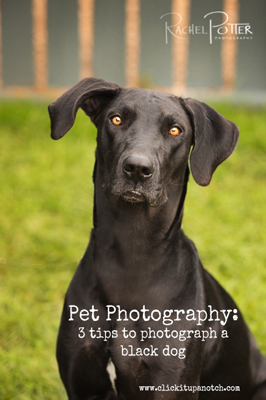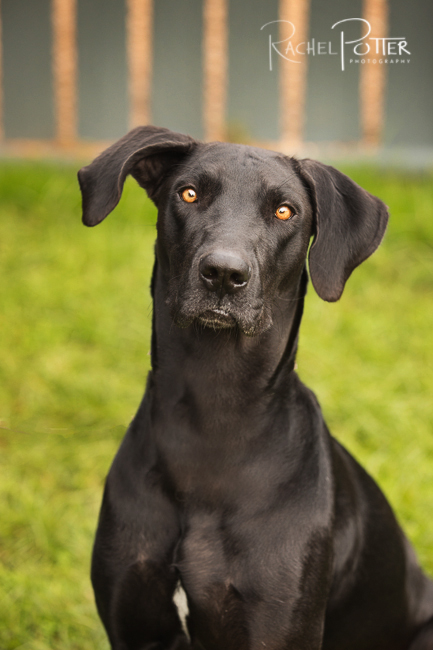Q: How do I photograph a black dog and not have it look like a black blob with eyes?
A: Ah yes.. the infamous challenge in pet photography of photographing a black dog. They are challenging for sure. Your camera’s focusing system relies on points of contrast in order to lock focus. With black dogs, there is very little contrast and so often the focusing systems continues to hunt for focus. So here are my best tips for getting a good image:
Light, Light, Light!
Preferably nice reflective light to help snag some catchlights or just add some depth and contrast to the fur…. something for your camera’s focusing system to latch onto.
Focus on the eyes.
While I always aim for the eye I also use the nose or in between the eyes for focus point in most situations. With black dogs that have brightly colored eyes, this provides you with a good contrast point for your focus.
Add something that will provide contrast for focus, a pretty collar for instance.
If you end up using something like that, make sure to increase you DOF (depth of focus) so that you can increase your chances of catching the face in focus as well.
If you find yourself with a black dog in less than optimal lighting, you will probably need a reflector or reflective surface of some sort. It is very challenging to hold a reflector around a dog and not have them freak out, so I prefer to position myself near a light colored wall or concrete that will help bounce the available light.
I can’t leave this question without addressing exposure. When metering a black dog you need to underexpose by at least a stop or two. Make sure you check your highlight warnings on you histogram and LCD. I find that I usually end up metering the scene and then do a test shot. I then adjust my exposure accordingly with the dog in place. I’d rather slightly over expose and adjust in RAW, then underexpose and have that detail lost.
Read more in the pet photography series
Pet Photography: Settings
Pet Photography: Focus and Lenses
Pet Photography: How to Photograph a Black Dog
Pet Photography: Getting THE Shot









I am loving this series, Pet Photography is what I am working towards I still have a long way to go but this has been so great having all these tips.
Thank you for this post. We recently got a new black mutt puppy who is the cutest thing ever but sometimes taking his photo is hard. I’ll have to try these tips next time.
Thank you! We adopted a black and white dog three months ago and I have been training my camera on him ever since. A lot of these things I did naturally anyway, but the light reflective surface is one I need to look into. It is so much fun trying to catch their personalities.
So glad you all are enjoying the posts! I’m happy to answer any questions either here Or email me : [email protected]
Great advice. We have a shih-tzu yorkie mix that photographs like a muddy-looking ball of fur most of the time – since I am a very amateur iPhone photographer, it is still a work-in-progress.
Sorry, I do ot get it. You say that with exposure, we should underexpose. Then you say that after metering, we should overexpose in raw so we do not loose detail in underexposing. i think you are trying to explain a difficult task in a simple way.
Yeah, seems like a typo. One of the things about digital photography versus film is the strictly limited range of the sensor. It can capture light levels from zero to its maximum ONLY. Any detail beyond that range is permanently lost and no amount of correcting in PhotoShop or LightRoom can ever retrieve the detail. It is very rare to lose detail at the dark end of the range. Invariably, it is the highlights that exceed 100% and get clipped at 100%. If your camera has a facility to show such clipped portions of you picture, use it. Or look at the histograms to detect over-exposure. If you lack such tools in the camera, deliberately under-expose by a couple of stops and use editing software such as LightRoom to correct the exposure later. I once applied this method to some caves in Jordan. On playing with the RAW files later I found some donkeys hidden in the darkness that I was unaware of as I took the shot.
So yes, heaps of light and preferably from a broad source like the sky, even an overcast day with lots of diffuse light. Under-expose so as not to lose highlight detail and play with exposure corrections on your computer. And keep experimenting along these lines until you understand the above.
And don’t forget to enjoy the puppy too!
Thanks for the advice! We have a small hotel for dogs and dog daycare, and one of my favorite hobbies is photographing our clients. I have a black doodle named Shadow that is a constant frustration, I just can’t capture him. I’ll try these tips next time I have a little session with him.